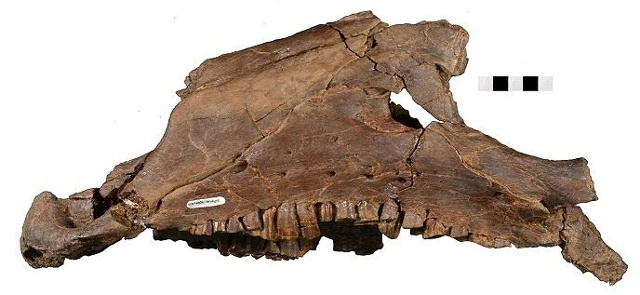- Tel: +86 813 2105845
- Fax: +86 813 2105845
- Mob: +86 13778532392
- Contact: Mr. Jacky
 info@dinosaurs-world.com
info@dinosaurs-world.com Jackydinosworld@gmail.com
Jackydinosworld@gmail.com Jackyyiming@gmail.com
Jackyyiming@gmail.com Jackyzengdinosaursworld
Jackyzengdinosaursworld
- Mines Research Reveals New Findings On One Of The Earliest Iguanodont Dinosaurs Of North America

New research published by paleontologists at the South Dakota School of Mines & Technology reveals an herbivorous dinosaur from the Black Hills as more than 20 million years older than previously thought.
Findings published this week in the online journal PeerJ are significant because they could help piece together the evolutionary picture of the Dakotadon lakotaensis and its descendants.
New research by South Dakota Mines paleontologist Darrin Pagnac, Ph.D., and Clint Boyd, Ph.D., former Mines paleontologist now employed with the North Dakota Geological Survey, determined the dinosaur is between 135 million and 127 million years old, putting it in the geologic age of the early Cretaceous period, making it one of the earliest types of such dinosaurs known from North America.
The fossil housed at the university is the only Dakotadon lakotaensis specimen known to exist.
Dakotadon lakotaensis is an iguanodont, a type of herbivorous dinosaur that lived throughout the northern hemisphere in the early Cretaceous period. Iguanodonts are characterized by an elongate, horse-like skull, robust hind limbs and shortened forelimbs with an immobile “spike” in place of a thumb.
The specimen was donated to the university’s Museum of Geology in the mid 1970s after Louis Rossow discovered it on his property east of Whitewood in an outcropping of the Lower Cretaceous Lakota Formation. In 1989, it was described as Iguanodon lakotaensis in a paper by David Weishampel and Philip Bjork, former Museum of Geology director. Subsequent work in 2008 revealed it to be a new genus, hence the new name Dakotadon.
The original site of excavation was relocated in 2014 with the aid of Rossow’s grandchildren. Relocation of the site helped Pagnac and Boyd determine the precise age of the specimen.
At the Paleontology Research Laboratory on campus, then preparator Mindy Householder conducted additional preparation and conservation, revealing new anatomy and other information not included in the original description.
Householder’s work exposed several new bones not included in the original description and revealed some bones that were previously misidentified. Extensive deformation due to fossilization processes in areas of the skull was also noted that influenced inaccuracies in prior descriptions and reconstructions, according to Pagnac and Boyd.
“Mr. Rossow discovered an exceedingly important specimen, the only of its type known worldwide. The cranial anatomy of Dakotadon is revealing a great deal about the evolution of these herbivorous dinosaurs between the late Jurassic and early Cretaceous periods,” said Pagnac.


 2015-09-28
2015-09-28
 New dinosaur species help scientists fill in evolutionary gaps
New dinosaur species help scientists fill in evolutionary gaps Feathered everything: just how many dinosaurs had feathers?
Feathered everything: just how many dinosaurs had feathers? Dinosaur Fossil With Fleshy Rooster's Comb Is First of Its Kind
Dinosaur Fossil With Fleshy Rooster's Comb Is First of Its Kind Scientists finally decode how dinosaurs turned into birds and learned how to fly
Scientists finally decode how dinosaurs turned into birds and learned how to fly Dark matter may have killed the dinosaurs, claims scientist
Dark matter may have killed the dinosaurs, claims scientist New duck-billed dinosaur uncovered in Alaska, researchers say
New duck-billed dinosaur uncovered in Alaska, researchers say
- Contact Us
- Tel: +86 813 2105845
- Fax: +86 813 2105845
- Contact: Mr. Jacky
 info@dinosaurs-world.com
info@dinosaurs-world.com Jackydinosworld@gmail.com
Jackydinosworld@gmail.com Jackyyiming@gmail.com
Jackyyiming@gmail.com Jackyzengdinosaursworld
Jackyzengdinosaursworld
- Copyright @ 2009 - 2020 Zigong Dinosaurs World Science & Technology Co.,Ltd.

